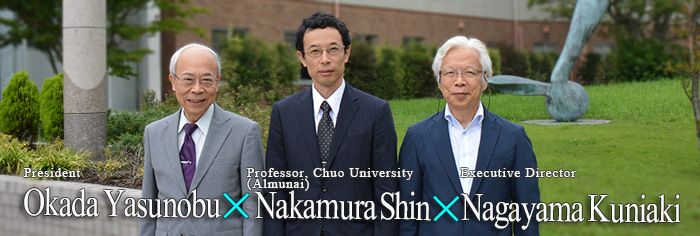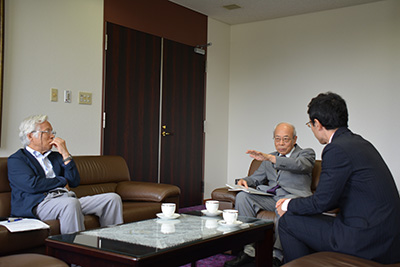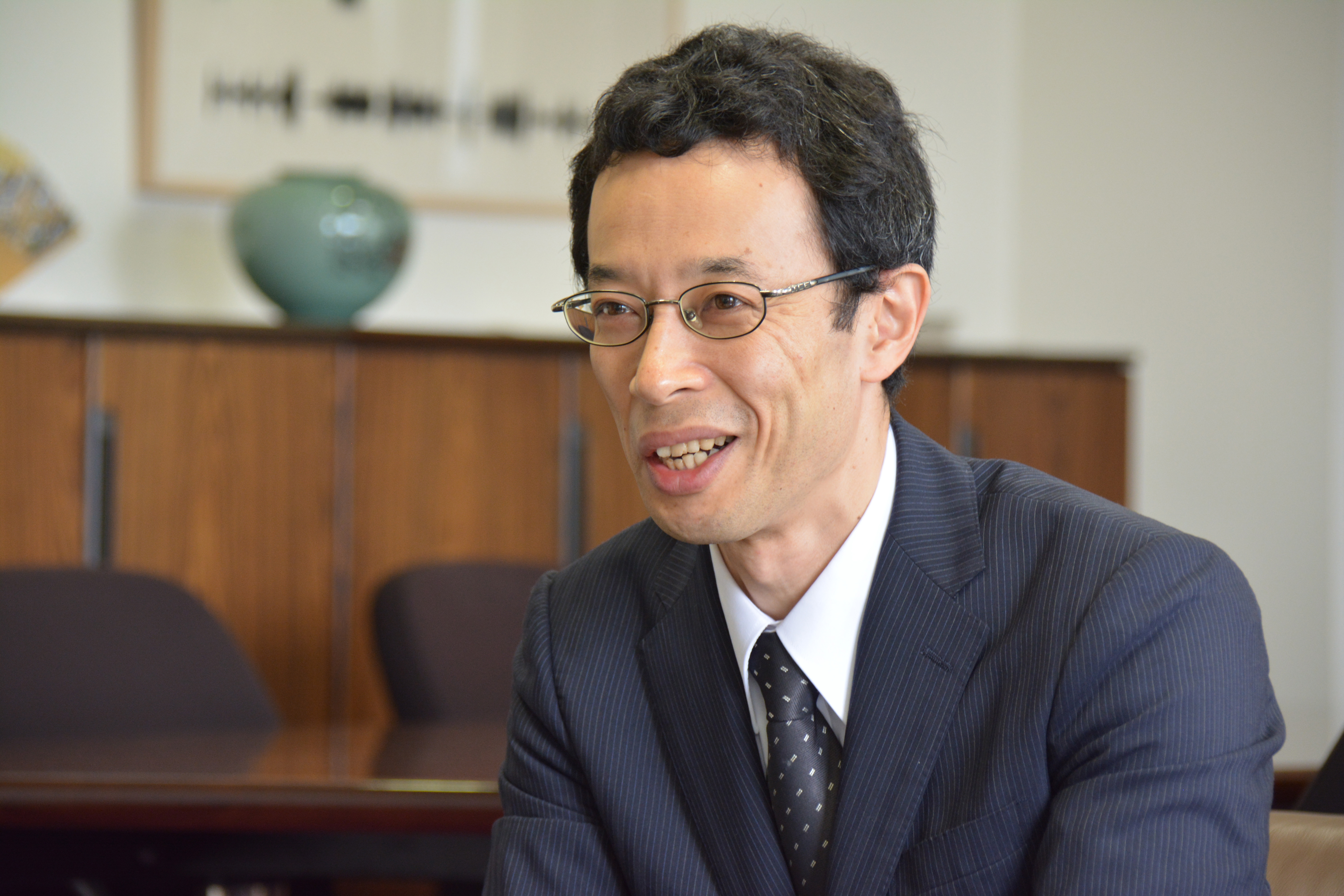[Interview] Professor, Chuo University Nakamura, Shin No. 2


The string that connects different fields? "Superstring Theory" intertwines across fields.
Okada: Let me ask as an amateur, can you explain the Superstring Theory in layman's terms?
Nakamura: Fundamental Particles Theory makes observations by breaking down the world, the universe, or materials into miniscule units. Superstring Theory represents a position in this field where we consider that the fundamental material units, which were thought to be dots of particles, are actually "strings."
There are many kinds of particles. There's the Higgs boson that was recently discovered and featured in the news. The Kobayashi, Masukawa Theory deals with another kind of particle called a quark. Different particles explain different phenomena. We provide each particle with its own corresponding theory, or to be more precise, a function in Theoretical Physics that we call a "field." Of course, there are instances when we use a unified approach, but in general we need to provide a field for each particle. So for instance, we might say, "let us designate this field to represent this quark."
However, the situation changes when we decide to explain things by using strings instead of particles. A single string can change its behavior by the way it vibrates. So, that string can behave as if it's a different kind of particle by changing the way it vibrates. Thus, we have incorporated the wave structure. By incorporating "length," which is an internal degree of freedom particular to strings, we were able to incorporate the characteristics of different particles into a single string, and this allowed us to think about different particles in a unified manner. This then makes it possible for us to think about connecting theories that were traditionally used for different purposes. It allows us the freedom to bring the mathematical ideas of a certain theory to another theory.
Okada: What about the Gauge/Gravity Correspondence? How is this related to what you have just explained?
Nakamura: For example, the milk in your tea follows fluid mechanics, and particles in fluids make fine complicated movements like Brownian motion. The physics that deals with these phenomena is called Non-equilibrium Physics. On the other hand, it is said that at the center of a galaxy in the universe, there is a supermassive astronomical object called a black hole. The gravity of a black hole is so strong that even light cannot escape. The physics of the tea example and that of the black hole adhere to completely different physics theories, but we consider them mathematically the same. String theory connects the two. By considering Superstring theory, we are able to connect the two. This is the Gauge/Gravity Correspondence.
Nagayama: Who discovered it?
Nakamura: It was discovered by an Argentinian physicist called Maldacena. He got his Ph.D. at Princeton University, and I think he's still there. He is probably about my age. It may have been toward the end of 1997 when he discovered it.
Nagayama: What kind of research are you working on right now?
Nakamura: The specific research I am working on at the moment is electrical conduction. How electricity flows when you apply an electric field to a substance is a many-body problem and a non-equilibrium problem. It generates heat, so it's not in equilibrium. When you apply a strong electric field in such a situation, electrical conduction departs from Ohm's law and yields all sorts of complicated behaviors. For example, normally, when you strengthen an electric field, the flow of electricity increases. However, there are phenomena in electrical conduction that exhibit non-linear behaviors, whereby when you strengthen the electric field, the current starts to decrease after a certain point. When you use the Gauge/Gravity Correspondence to consider electrical conduction with a certain model, you are able to recreate such behaviors using the Superstring Theory and General Theory of Relativity.
And vice versa, we are able to discover new phenomena that were unknown in experiments or in normal theories of physical properties, by performing analysis using the physics terminologies for black holes. Of course, whether such phenomena actually take place must be confirmed through experimentation, but in terms of the theoretical possibility, we have discovered a new possibilities.
The Japanese language and the Japanese people in science, Japanese craftsmanship, and the West's power of imagination, unconstrained by concerns about what is perceived to be common sense.
Okada: We are able to engage in such theoretical and scientific thinking in Japanese. In Asia, there aren't many countries where people can use their own language to think about all the sciences. In that sense, Japan is very blessed.
Nakamura: I was abroad for a total of about five years, and I did get that impression. For example, during my stay in Korea, I heard that in many cases students start using English textbooks at the undergraduate level. Korean researchers told me that they are envious that we have so much specialized literature written in our mother tongue. Similar situations persist in western non-English speaking countries. I think Japan is unique in that we are able to discuss our fields in our mother tongue.
Okada: I am beginning to think that Japan may be able to contribute to science from a different angle, one that complements western theoretical explanations.
Nakamura: I think one of the Japanese characteristics is that each researcher harbors a craftsman-like pride. For example, researchers make sure that they produce the correct result for even a single calculation. They are certain that for that particular type of calculation in that particular genre, they are the best in the world. It's as if they are craftsmen, and they see beauty in this sort of ethic. On the other hand, perhaps because of the style of education, people in the west tend to be unconstrained by worries about what makes common sense as they generate ideas. This is contrary to the Japanese nature, where we tend to choose common-sense paths.
Okada: You've mentioned that in a previous lecture, and you told the audience not to be caught up in common-sense scenarios, but to move forward without "knocking on the stone bridge."
( For Dr. Nakamura's lecture upon receiving the SOKENDAI Scientist Award, click here. )

Nakamura: Relying on common sense doesn't get you anywhere, and this is especially true in life (laughter).
Okada , Nagayama: (laughter)
Nagayama: It's quite impressive that you reached that point. To put it another way round, I think it is astonishing that you were able to think about the physics of black holes and the Superstring Theory as being connected with the physics of the everyday world, like electrical conduction.
Nakamura: I think it's the fruit of my wanderings. After I came back from Korea to Japan, I stayed for a year in the fundamental particle group in Kyoto University. After that, I was appointed for a total of 4 years to a group that works on nuclear theory. This might not seem like much of a difference to people outside of the field, but in terms of the finer categories, they are different fields. I think being in different fields was very good for me.
Actually, at first I tried to apply the Superstring Theory to Nuclear Physics. However, this field has a long history, and is at a stage where a more precise theory is needed. This means that I may come very close to proving something using the Superstring Theory, but rarely reach the point where the result itself is "usable." That was when I thought, "what about the physics of non-equilibrium"?
In the field of Statistical Physics, which is the basis of Non-Equilibrium Physics, you are not caught up with the details. Strictly speaking, water and oil may not be the same, but in terms of fluid mechanics, all that is required is that the material be fluid. Thus, how particles move as groups is more the issue rather than what sort of characteristics they each possess. If I compare this with the movement of money, it is like dealing with the national economy rather than a household budget. Economics deals with averaged group behavior at the national scale rather than documenting the precise behaviors of each individual. This means that a certain behavior may be recognized and documented as identical in Japan and Germany. Similarly, in Statistical Physics, there is the possibility that we may engage in a common physics discussion that goes beyond minute differences, and in the case of Non-Equilibrium Physics, very little was known back when this idea came to me. I saw a possibility that my methods might prove to be effective.
As it turned out, I wandered quite a lot and experienced different worlds, because my graduate school years were not very straightforward. I think all of that was ultimately beneficial and helped me to reach my current level of research.
Okada: People who don't take the straight path and have the ability to jump over obstacles may be the ones with the most energy.
Nakamura: In my case, I changed my path after three years of graduate school, so I couldn't imagine that any university would accept me open-handedly. However, because SOKENDAI is a graduate university and is not connected with undergraduate institutions, it's easier for graduates of other universities, or those who have experienced other careers to enter.
p.2/3
Related Content
